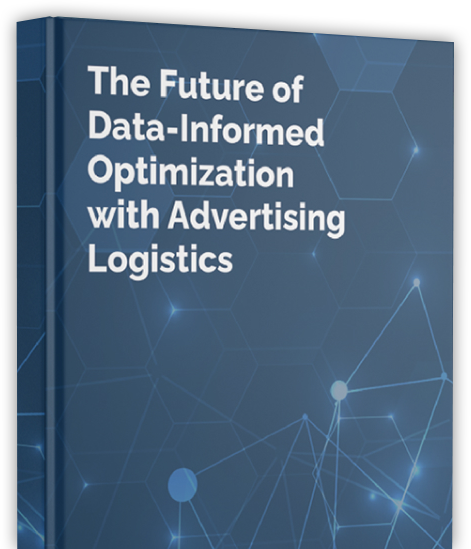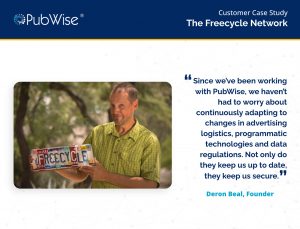Description
It was only 2018, when the USPTO issued U.S. patent number 10 million. That same year there were 285,095 utility patent applications filed in the US, and only 50% were granted. This was the year we filed an application with the USPTO, and we’re not only excited that we were granted a utility patent for our Smart Path Optimization Technology (SPOT), but we can also finally talk about it! In this podcast, CTO and Founder Stephen Johnston talks about what makes their patent unique in the programmatic ad space and how it significantly decreases their customer’s carbon footprint.
Transcript
Tony Winders: Hello, and welcome to another edition of On the SPOT. My name is Tony Winders. And today I’m putting PubWise Founder and CTO Stephen Johnston On the SPOT about the company’s recent patent award related to its Smart Path Optimization Technology. Stephen, always a pleasure, great to chat with you, again. Recently, PubWise announced that it had been granted a patent related to Demand Path Optimization, specifically a digital advertising platform with Demand Path Optimization. And I know that’s related to the Smart Path Optimization Technology suite or SPOT. Maybe just start by talking about what SPOT is, and then we can talk a little bit about how the patent relates to that.
Stephen Johnston: So SPOT is a global name for all of our optimization technologies. This stands for Smart Path Optimization Technology and we call it the SPOT suite. What we’re trying to get across there is that there’s an ensemble or group of activities that are related to Smart Path Optimization. And we’re differentiating from just the demand path and just supply path and trying to find ways to accomplish those potentially antagonistic processes more harmoniously. So, how do we find ways to benefit both the seller and the buyer? Instead of merely driving down costs, getting more value, instead of merely driving up revenue, providing more performance. I’m a technologist, I’d love to say that we could do that with one grand algorithm, but the reality is that we have a patent on a technology that’s primarily Demand Path Optimization and it optimizes the header-bidding configuration, to provide thousands of optimizations beyond what a human team could do. It largely turns off and on bidders or configures how bidders are participating in an auction, dynamically across the world and devices. And we have in the works, more patents, but live, we have a lot of good processes, automation, analytics, human insight, human activity, just good dashboarding, good UI’s that let you, as a human, do things that you need to configure your programmatic advertising. And a complete focus on observability in order to provide that information, both to us and the publisher, so that they can be informed about how they can improve things. How to use a publisher to improve the perception of value, by the buy side in order to drive up revenue. And that’s really what the suite is about, is that whole cluster of activities, not just the algorithmic components.
Tony Winders: What I thought was really most compelling, well, there were two things about the announcement that you made related to the patent. One was this idea that PubWise is able to optimize up and down the supply chain. I mean, specifically, achieving the objectives of the publisher and the advertiser, simultaneously. How much of that is future state versus something that is happening now in the SPOT technology?
Stephen Johnston: Well, I think that what you describe there is the goal. In the hierarchy, that’s the goal of everything. Our entire focus is on making sure that the things we’re doing are beneficial to both sides. And so it all relates to that. But these are things like, not doing 10 second refreshes on an ad. Because you might have a publisher who says, “I want more ads on the page or more ads to show,” but the demand side doesn’t really value that. And, it leads to ad exhaustion, it leads to just poor behavior, and it’s potentially a violation. And so when we talk about meeting the needs of both sides, I think that is just pervasive in everything we do. The patent, on the demand path patent, delivers on that, specifically, from the supply side. We have more of just proprietary systems and implementation in future patents on how to do that on the exchange layer. But we’re doing that across the system now with a mix of algorithmic inventions and just good business processes.
Tony Winders: Thank you, I got it. The other thing that I thought was really interesting about the announcement was the fact that your technology reduces waste and environmental impact, how does that play into all of this?
Stephen Johnston: We can reduce bid volumes from a publisher by as much as 40% with the same or better performance, essentially improving revenue with less bid volume. Whatever the carbon footprint impact of our publisher is to that downstream supply chain, we can reduce as much as 40%. So when you just talk about percentage value, it’s pretty impactful. And I think if you’re out there saying you can reduce by 40%, any source of carbon, people would be very interested. So you get into measurement, does a wasted bid contribute as much as a valid bid because there’s more activity? We can get into a deeper debate about relative contributions. But what we know is that we reduce waste. And so in the classic reduce, reuse, recycle, we’re very much on the reduce side of that, and let’s just not contribute to the problem as much as we can, while still realizing that the only campaign that doesn’t contribute to carbon is the one that doesn’t get run. That’s not workable, these are businesses, they have to achieve their goal. But how do we draw the balance, get as much value as we can, without wasting things? And we’ve always been focused on waste as a concept around our optimization. Let’s find errors, because that’s a source of waste, let’s find where we’re sending unnecessary bids, because that’s a source of waste. And all those things contribute to our publishers simply not doing things that waste resources that then lead to carbon emissions and the like.
Tony Winders: How can other stakeholders in the programmatic ecosystem get involved in what you’re working on?
Stephen Johnston: So we’re building a Smart Path Optimization Technology system with a focus on radical observability, for everyone involved. And I think that we’re seeing the industry talk more about transparency, observability, providing more information, whether that’s about pricing decisions, fraud distinctions, or carbon emissions. We are absolutely interested in working with any partners out there who similarly want to work along those lines, who want to be observable, who want to share information, who want to provide opportunities for both sides of these transactions to benefit, supply and demand. And I’d like to say that’s everybody in the industry, but it’s not. Everybody doesn’t really have a commitment in their bones. So those who do, we want to talk to. Other than that, we work with everybody across the industry. But we’re looking for strategic partnerships or like-minded people to work with and deliver this reality.
Tony Winders: The patent announcement is just one small component of a bigger suite and a lot of exciting things that are going on at PubWise so I appreciate you delving into this piece of it. There’s a lot more to talk about in the weeks and months ahead. But congratulations on that announcement.
Tony Winders: Thank you, Stephen. This has been On the SPOT with PubWise Founder and CTO, Stephen Johnston. I’m Tony Winders. And I look forward to seeing you in our next episode. Thanks again.





